Partridges, Quails, Francolins, Snowcocks, Guineafowl, and Turkeys
Partridges, Quails, Francolins, Snowcocks, Guineafowl, and Turkeys
Partridges, Quails, Francolins, Snowcocks, Guineafowl, and Turkeys
You also want an ePaper? Increase the reach of your titles
YUMPU automatically turns print PDFs into web optimized ePapers that Google loves.
Resources: Needs will depend on the length <strong>and</strong> scope of<br />
individual projects.<br />
4.3 Strategic project<br />
Project 10. Taxonomic reassessment of<br />
some partridges <strong>and</strong> New World quails<br />
Aim: To revise species-level taxonomy in some of the<br />
partridges <strong>and</strong> New World quails.<br />
Although known from Peninsular Malaysia, Sumatra, <strong>and</strong> Borneo,<br />
the black wood-partridge (female shown here) is threatened by<br />
severe <strong>and</strong> continuing habitat destruction.<br />
Justification: Knowledge of Indonesian partridges is poor<br />
(Holmes 1989). The country has the longest list of birds<br />
believed to be threatened with extinction, but in many<br />
cases this reflects problems presumed to have arisen as a<br />
result of habitat loss or degradation, rather than direct<br />
evidence of declines in numbers. The threats facing<br />
Indonesia’s biodiversity are very real, but the continuing<br />
lack of baseline information on partridges prevents any<br />
objective assessment through which to propose the most<br />
appropriate conservation action. New information on the<br />
threatened partridges known to occur on the isl<strong>and</strong> is<br />
needed, but existing information must be collated <strong>and</strong><br />
assessed. A protected area network was identified in a<br />
recent study of Asian Galliformes (McGowan et al. 1999).<br />
Project description: The isl<strong>and</strong> of Borneo covers 755,000km 2<br />
<strong>and</strong> comprises three countries. This means that establishing<br />
the distribution <strong>and</strong> status of all its Galliformes will not be<br />
an easy task, but there is much scope for survey teams from<br />
within or outside Indonesia, Malaysia, <strong>and</strong> Brunei to<br />
survey parts of the isl<strong>and</strong> at various times of year. Through<br />
networking with other Specialist Groups, the PQF<br />
Specialist Group will attempt to collate any other site<br />
records for species in Borneo, as well as their apparent<br />
absence from localities within their known areas of<br />
occurrence. At a minimum, information on exact locality,<br />
altitude, date, <strong>and</strong> habitat type should be collected.<br />
Information on other species should also be collected <strong>and</strong><br />
provided to the relevant SSC Specialist Group. All<br />
information should be made available to the WPA Asian<br />
Galliformes Sites Database <strong>and</strong> BirdLife International’s<br />
World Bird Database.<br />
Timescale: Projects of any duration can contribute useful<br />
information.<br />
© Lynx Edicions<br />
Justification: Conservation, fundamentally, is based on<br />
the management <strong>and</strong> protection of natural resources, <strong>and</strong><br />
the species remains the most practical level at which to<br />
direct conservation action. Such action, therefore, relies<br />
on identifying <strong>and</strong> defining species limits. However, recent<br />
advances in taxonomic thinking (e.g., species concepts,<br />
Evolutionarily Significant Units) <strong>and</strong> phylogenetic analysis<br />
have thrown significant doubt on whether current<br />
systematic treatments, in particular the presently accepted<br />
species boundaries within the hill-partridges Arborophila<br />
<strong>and</strong> wood-quails Odontophorus, are correctly reflecting<br />
biological diversity in these genera. There is an urgent<br />
need for a revision of these species’ taxonomy, as there is<br />
dispute over the several forms that have variously been<br />
treated as subspecies <strong>and</strong> full species.<br />
Project description: A variety of taxonomic methods should<br />
be used to examine the question of species limits in<br />
partridges <strong>and</strong> wood-quails, <strong>and</strong> look at possible<br />
implications for conservation. Further species-level<br />
taxonomic investigation should focus particularly on some<br />
of the Arborophila species of Asia, where there is much<br />
doubt over treatment of the various subspecies (e.g., the<br />
two subspecies of the chestnut-headed hill-partridge <strong>and</strong><br />
The threatened Annamese subspecies merlini of the chestnutnecklaced<br />
hill-partridge has been treated by some as a full species.<br />
© Lynx Edicions<br />
46

















